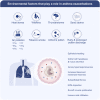Epithelial barrier hypothesis: Effect of the external exposome on the microbiome and epithelial barriers in allergic disease
- PMID: 35108405
- PMCID: PMC9306534
- DOI: 10.1111/all.15240
Epithelial barrier hypothesis: Effect of the external exposome on the microbiome and epithelial barriers in allergic disease
Abstract
Environmental exposure plays a major role in the development of allergic diseases. The exposome can be classified into internal (e.g., aging, hormones, and metabolic processes), specific external (e.g., chemical pollutants or lifestyle factors), and general external (e.g., broader socioeconomic and psychological contexts) domains, all of which are interrelated. All the factors we are exposed to, from the moment of conception to death, are part of the external exposome. Several hundreds of thousands of new chemicals have been introduced in modern life without our having a full understanding of their toxic health effects and ways to mitigate these effects. Climate change, air pollution, microplastics, tobacco smoke, changes and loss of biodiversity, alterations in dietary habits, and the microbiome due to modernization, urbanization, and globalization constitute our surrounding environment and external exposome. Some of these factors disrupt the epithelial barriers of the skin and mucosal surfaces, and these disruptions have been linked in the last few decades to the increasing prevalence and severity of allergic and inflammatory diseases such as atopic dermatitis, food allergy, allergic rhinitis, chronic rhinosinusitis, eosinophilic esophagitis, and asthma. The epithelial barrier hypothesis provides a mechanistic explanation of how these factors can explain the rapid increase in allergic and autoimmune diseases. In this review, we discuss factors affecting the planet's health in the context of the 'epithelial barrier hypothesis,' including climate change, pollution, changes and loss of biodiversity, and emphasize the changes in the external exposome in the last few decades and their effects on allergic diseases. In addition, the roles of increased dietary fatty acid consumption and environmental substances (detergents, airborne pollen, ozone, microplastics, nanoparticles, and tobacco) affecting epithelial barriers are discussed. Considering the emerging data from recent studies, we suggest stringent governmental regulations, global policy adjustments, patient education, and the establishment of individualized control measures to mitigate environmental threats and decrease allergic disease.
Keywords: air pollution; climate change; epithelial barrier; exposome; nutrition.
© 2022 The Authors. Allergy published by European Academy of Allergy and Clinical Immunology and John Wiley & Sons Ltd.
Conflict of interest statement
Dr. Akdis reports grants from Allergopharma, Swiss National Science Foundation, Christine Kühne‐Center for Allergy Research and Education, European Commission’s Horizon's 2020 Framework Programme, Cure, Novartis Research Institutes, Astra Zeneca, Glaxo Smith‐Kline, Scibase, advisory role in Sanofi/Regeneron, Scibase, Novartis, Glaxo Smith Kline. Other authors declare no conflicts of interest in relation to this work.
Figures





References
-
- Holloway JW, Yang IA, Holgate ST. Genetics of allergic disease. J Allergy Clin Immunol. 2010;125(2 Suppl 2):S81‐S94. - PubMed
-
- Vrijheid M. The exposome: a new paradigm to study the impact of environment on health. Thorax. 2014;69(9):876‐878. - PubMed
-
- Agache I, Miller R, Gern JE, et al. Emerging concepts and challenges in implementing the exposome paradigm in allergic diseases and asthma: a Practall document. Allergy. 2019;74(3):449‐463. - PubMed
Publication types
MeSH terms
Substances
LinkOut - more resources
Full Text Sources
Medical

